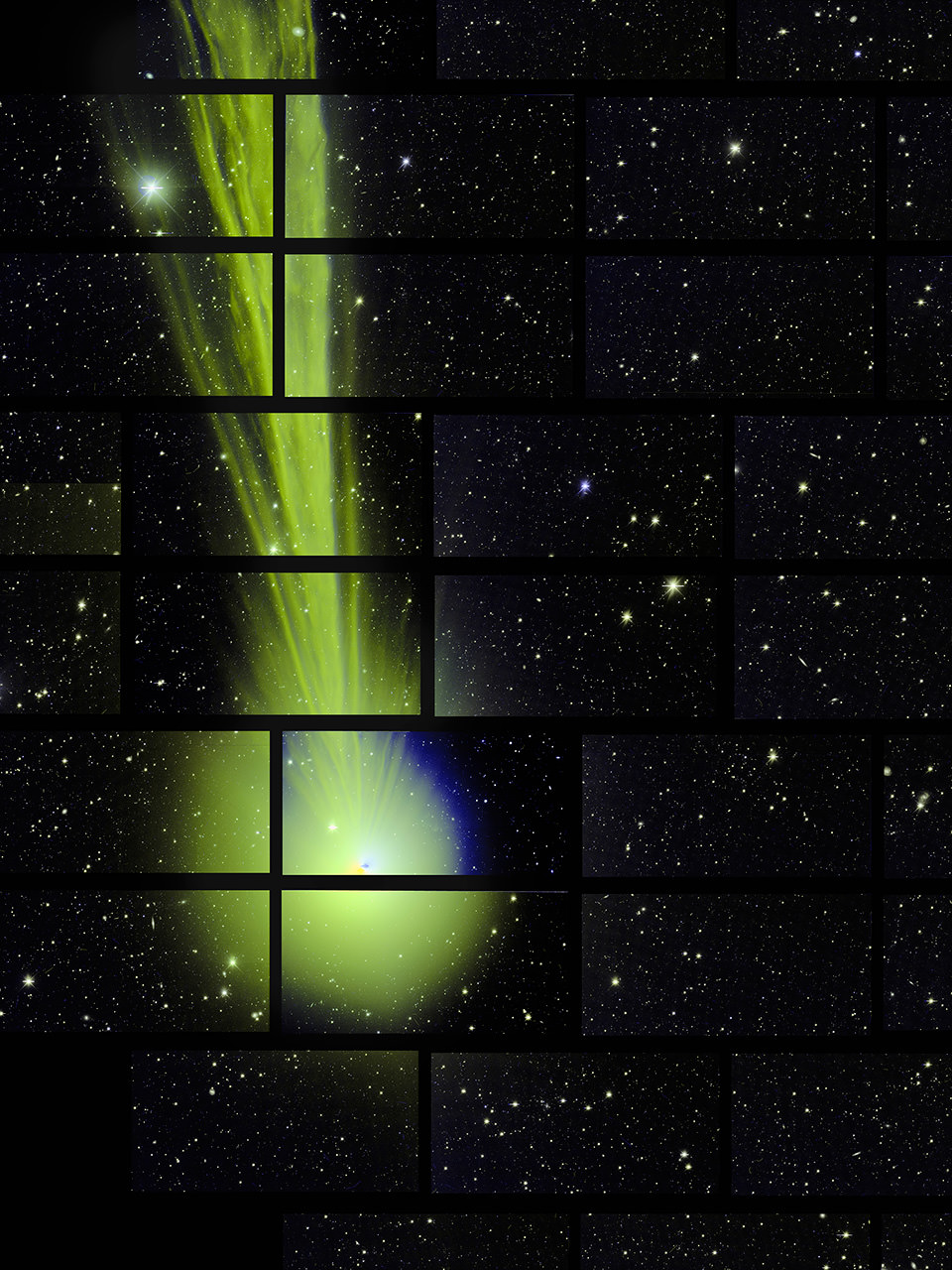Oops! In a happy accident, Comet Lovejoy just happened to be in the field of view of the 570-megapixel Dark Energy Camera, the world’s most powerful digital camera. One member of the observing team said it was a “shock” to see Comet Lovejoy pop up on the display in the control room.
“It reminds us that before we can look out beyond our Galaxy to the far reaches of the Universe, we need to watch out for celestial objects that are much closer to home!” wrote the team on the Dark Energy Detectives blog.
On December 27, 2014, while the Dark Energy Survey was scanning the southern sky, C2014 Q2 entered the camera’s view. Each of the rectangular shapes above represents one of the 62 individual fields of the camera.
At the time this image was taken, the comet was passing about 82 million km (51 million miles) from Earth. That’s a short distance for the Dark Energy Camera, which is sensitive to light up to 8 billion light years away. The comet’s center is likely made of rock and ice and is roughly 5 km (3 miles) across. The visible coma of the comet is a cloud of gas and dust about 640,000 km (400,000 miles) in diameter.
The Dark Energy Survey (DES) is designed to probe the origin of the accelerating universe and help uncover the nature of dark energy by measuring the 14-billion-year history of cosmic expansion with high precision.
The camera just finished up the third, six-month-long season of observations, and the camera won’t be observing again until this fall.
You can download higher resolution versions of this image here.


This is the best post ever!
Even David Dickenson can’t match this. Wow!
Even Rosetta won’t have this perspective. Wow again!
Don’t you just love serendipitous science!
I copied the image above to take a closer look and found the star fields do not overlap. Do the gaps in the data get filled in later?
Considering this is just about half the frames of the camera, I’m going out on ledge and say they will have overlapping data when searching deep.
Best accident ever happen! Amazing photo!
Wow! what an accident from 51 million miles I agree with Far Away Long Ago this is the best picture ever just Beautiful…
Best photobomb ever.
Wow stunning!
I know this might be a silly question to ask, but I must, any signs that dark matter is present around this comet? And what’s up with the section containing the “core” of the comet? I zoomed in on the med-res picture and you can see something is there, even in that same frame, the hallow surrounding it is different. Why???
Very cool picture indeed.
The dark matter camera is not something that can image dark matter. Instead it tries to detect dark matter by the bending of light from objects behind it. Spectacular gravitational lensing effects like ‘Einstein’s Cross’ are rare. That the camera is looking for is much more subtle bending. This technique works on very massive, very distant objects against a background of even more distant objects. We don’t know the actual positions or appearance of these very distant objects, so there is some guesswork involved.
So, the answer to your question (not a silly question) is the camera is probably not detecting any dark matter. A comet is too light to bend light significantly unless is was made of something very unusual, and we have recently landed on one of these things, so we know quite a lot about their gravity. It is probably too big in the camera view for the usual dark matter mapping techniques to work too.
I think the DES people have probably got the BICEP 2 results in mind here. When you are trying to plot out massive gravitational structures for the very early universe, you have to remember all the other stuff that might be between you and what you are trying to measure. Not all of the stuff out there shows up like Comet Lovejoy.
As for the other effects you were seeing: this is called a camera, but it is effectively an array of cameras with lots of light baffles to stop the flare from one bright object fogging all the detectors. They have given you the raw data because it is good to look at, but I would not read too much into the differences between the detectors.
Mr. Kirk, please, it is a dark energy camera, not a dark matter camera.
It is intended to study the acceleration of very distant objects, not the effects of their gravity or that of closer objects.
I believe the dark stripes in the picture are from the separation of the multiple sensing elements, CCD arrays if you will, not from baffles, but that is only a semi-educated guess.
I do, however, thank you for your erudite explanations of many other phenomena posted here.
After seeing the Rosetta pictures, are we still so sure about the “ball of ice”?
I thought it was “dirty snowball”, which I still think is an apt if not totally accurate description of a comet.